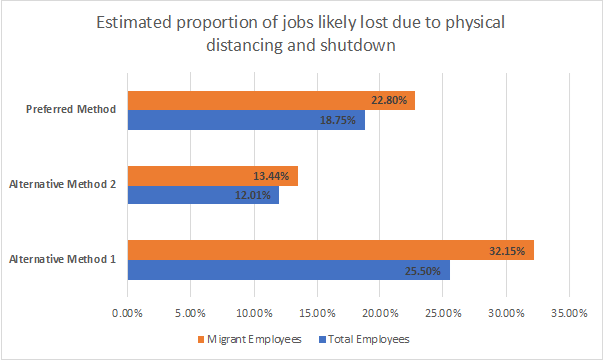The COVID-19 pandemic could have pushed up to half of Lao migrant workers in Thailand out of work
We knew the COVID-19 in Lao PDR and Thailand, and the subsequent lockdown would be difficult for workers and their families. However, we had hoped the impact of the pandemic would not be this severe.
We at Emerging Markets Consulting have been working on ways to estimate the impact of the COVID-19 lockdown on migrant workers in Lao PDR and Thailand on behalf of the International Organization for Migration.
It is a complicated task, with few precedents in the research literature.
The results, detailed in a new report: Assessing Potential Changes in Lao Migration Trends and Patterns, are distressing.
We estimated that between 13 and 32 percent of migrant workers in Lao People’s Democratic Republic and between 24 and 49 percent of Lao migrant workers in Thailand would have been out of work as a result of physical distancing measures to contain the spread of COVID-19 back in April 2020.
It derives from multiple sources of information.
The basis of this research is data from the United States Department of Labor on the amount to which each occupation requires workers to be near other people and if they can work remotely.
The physical proximity requirements of a job and the ability to work from home are likely to be good indicators of how likely a worker will be laid off – permanently or temporarily – during the lockdown.
Our second source of information is a set of estimates by the Grattan Institute of the magnitude to which jobs are under threat in each industry in Australia. We assume the estimates for Australia are applicable for Lao PDR, given the similarities of the COVID-19 response policies in each country.
Our preferred method for estimating the employment shock is an average of these sources.
We also use two complementary approaches, each of which relies on a single source of data, representing lower and upper bounds.
Figure 1: About one-fifth to one-third of migrant workers in Lao People’s Democratic Republic are likely to be out of work due to COVID-19.

Our preferred method finds that about 23% of migrant workers in Lao People’s Democratic and 36% of Lao migrant workers in Thailand could have been out of work due to government-mandated lockdown and physical distancing.
Figure 2: About one-quarter to one-half of Lao migrant workers in Thailand are likely to be out of work due to COVID-19.

Unsurprisingly, we find that migrant workers in accommodation and food services will likely be the hardest hit, with more than half of workers in that industry out of work.
Economic activities classified as arts, entertainment and recreation are not far behind accommodation and food services.
A range of other industries – where people are more likely to work remotely – are much less likely to lay off workers in the weeks and maybe months ahead.
This report represents our best attempt to estimate the size of the shock under conditions of extreme uncertainty and limited information.
In some cases, our preferred method yields results that are likely overestimating the share of migrant workers who are at risk of joblessness. This includes industries such as finance and insurance activities and mining and quarrying.
Nonetheless, our estimates strongly correlate with anticipated layoff figures by firms in response to the social distancing and lockdown measures in place back in the second quarter of 2020.
Figure 3: Our preferred method of industry-level job loss estimate is broadly in line with LNCCI survey data.

Source: Author’s calculations; Coates’ et al. (2020); LNCCI (2020). Note: Industries shown are only those with above 10 respondents in the LNCCI survey.
While our estimates are not akin to a crystal ball, it is clear that migrant workers in Lao PDR and Thailand now face one of the worst employment shocks in modern history.

Comments are closed.